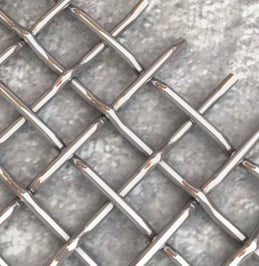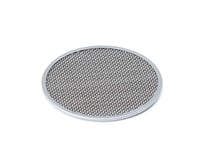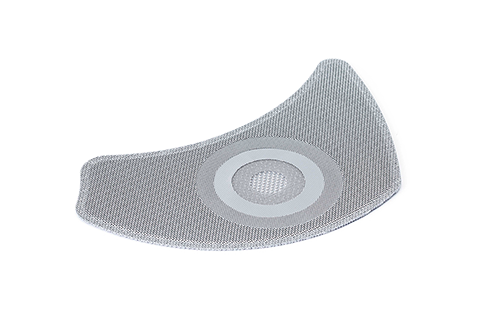What Is a Screen Pack? (Definition, Components, and Cost + Video)
At W.S. Tyler, we specialize in woven wire mesh. One of our focuses is on customized filtration products. As you can imagine, “customized filters” is such a wide category.
The problem is that we have made filtration products for such a wide range of industries like oil and gas, food and beverage, pharmaceutical and medical and so many more.
So, although a product group like this lets us use our engineering expertise and our wire mesh capabilities, even we struggle to imagine all the possibilities.
We don’t have a lot of chances in this product line to talk about a standardized product except in the plastics industry.
One of our most commonly made “customized filters” is an extruder screen. Sometimes these filters are also called screen packs, both mean the same thing.
Extruder screens are a necessity for any extruder of polymer or plastic. We are going to explore all things extruder screens in this article, from definitions to pricing to how they are made.
What Is a Screen Pack?
A polymer material needs to be formed into the desired shape. This is true whether it’s being used to produce bags, bottles, flat-screen TVs, clothing, or automotive components.
The material generally starts in pellet form. Those small pieces need to be run through some sort of manufacturing operation or they need to be extruded into a desired state.
The material needs to be processed through melt and filtration operations to be sure the material is clean and pure. This is where a melting system with extrusion screens comes in.
Screen packs, often referred to as extruder screens, are either single-layer or multi-layer wire filtration systems that are welded together and made into specific shapes and sizes.
The melted material is forced through a wire mesh screen in order to remove any contaminants before continuing on to the next process.
Different layer configurations and micron ratings (mesh opening sizes) can be used depending on the level of decontamination required, pressure requirements, or characteristics of the material being filtered.
These screens are changed out frequently during a filtration process, and typically are not able to be cleaned or reused.
Extruder Screen Pack Design
Extruder screens are manufactured to lots of different specs. The mesh that makes up the screen will be the exact opening size for your process and the size and shape will be dictated by your machines.
Here is how an extruder screen is made:
- Wire mesh specifications with an appropriate micron rating are chosen
- Materials are layered and joined together in a spot welding operation
- Spot welded material continues on to a punching operation utilizing compound tooling
- The resulting Extruder Screens are separated from skeleton/waste material
- Finished Extruder Screens are cleaned
- Clean Extruder Screens are shrink-wrapped in preparation for shipping
Components
There is a misconception that since extruder screens are not reusable, they are easy to make or a “cheap version” will do. This is not the case.
Extruder screens are a key part of any polymer or plastics extrusion process.
There are a few key components to an extruder screen that we want to cover. These components should help you select the best manufacturer for your processes to offer long-lasting and reliable screens.
Welding
It is important to choose a manufacturer that welds your screens properly. While extruder screens are available from all over the world at different price points, quality is key.
Your screens need to be welded properly to ensure they don’t bend, stretch or break. This type of effect can alter the opening sizes in your mesh and change your filtration results.
This will also result in needing to change your screens more often and in the end, will cost you more money.
Wire Mesh Screen

The mesh in your screen, whether single-layer or multi-layer, needs to hold up against the material you are filtering. You don’t want your screen to rust or corrode during your process.
Stainless steel is preferred if the polymer being processed could corrode mild steel, or if the chance for contamination by oxidized steel screen material should be avoided.
A nickel-alloy mesh should be used for extruding fluoropolymers that could corrode typical stainless steels.
Opening size and weave type are also important to the quality of the screen.
Micron ratings/mesh counts vary widely depending on your desired outcome.
Square mesh is most widely used for its flow capability, but filter weaves (Dutch Twill and others) can also be used for finer filtration.
Typical square mesh counts and associated micron ratings will range from 18 mesh (1000 micron) to 500 mesh (25 micron).
If you are looking for more information on the woven wire mesh itself, check out our article: Guide to Woven Wire Mesh (Cost, Weave Types, & Vocabulary).
Single-layer or Multi-layer
 Extruder screens can be made with both one layer of wire mesh or multiple layers. A single-layer is used when virgin material with few impurities is being processed.
Extruder screens can be made with both one layer of wire mesh or multiple layers. A single-layer is used when virgin material with few impurities is being processed.
Multi-layer is used when reground or recycled material is being used or when absolute cleanliness is a must. There is typically a more coarse protection layer that the melted polymer first comes in contact with.
This protects the finer filtration layer or layers from debris damage, pressure, or the swirling motion of the plastic melt. Another coarse layer faces the breaker plate to support and protect the finer mesh layer from being pushed into the breaker plate holes.
Configurations vary depending on a wide variety of factors, such as material type and cleanliness requirements, but extruder screens typically contain 2 to 5 layers.
That layer could be held together with spot welds, a rim-binder, or the layers could simply be unsecured and stacked in the desired configuration.
Shape
 Extruder screens usually come round or kidney-shaped. Round screens are usually used one at a time and the filtration process is stopped in order to change the screen.
Extruder screens usually come round or kidney-shaped. Round screens are usually used one at a time and the filtration process is stopped in order to change the screen.
Kidney-shaped screens are used in multiples around a screen-changing wheel that automatically advances to the next screen when clogging or a pressure increase is detected. This type of system allows the process to run uninterrupted and an operator can replace clogged screens while the melt flow continues with new screens.
Size
Sizes vary widely with each style. Depending on the type of material and volume desired, round screens can be less than 1” in diameter or exceed 16” in diameter.
Likewise, kidney-shaped screens typically range in size from 2.5” x 3” to larger than 3.5” x 6.5”.
How Much do Extruder Screens Cost?
The price you can expect to pay for extruder screens is going to depend on a number of factors including:
- Size
- Shape
- Number of layers
- Quantity purchased
- The cost of each individual mesh specification chosen
- Any special processing required
- Alloy
A rough estimate on cost would be about $.20 each for small single-layer screens bought in high volume to well over $20 each for large multi-layer screens bought in low volume.
How Often Do I Change Out my Extruder Screens?
While good extrusion screens are a quality product, they are made to be used, changed, and discarded at regular, frequent intervals.
How often they need to be changed out is going to be dictated by your processes, how dirty the melt is, or how much of the impurity needs to be taken out.
Screens with clean melt running through them could last days or weeks without change/replacement, while dirty recycled material may need the Extruder Screen replaced several times per hour.
To Sum It Up:
Finding the right products can be difficult, no matter what you are looking to buy. Finding the right manufacturer for your needs can be even more difficult because it's hard to know true quality just from pictures.
Whether you decide to purchase your Extruder Screens from us or from someone else, we want you to be an educated buyer. We hope this article helped you to understand what goes into making one of these screens, and how to know what to look for when purchasing them.
If you have any other questions about our extruder screen capabilities, send us a message and we'd be happy to discuss it with you.





